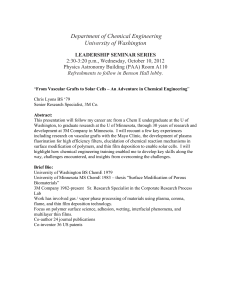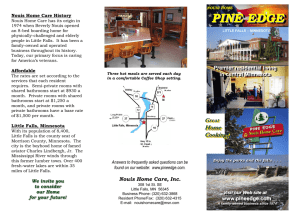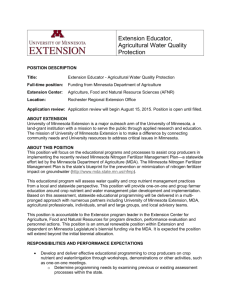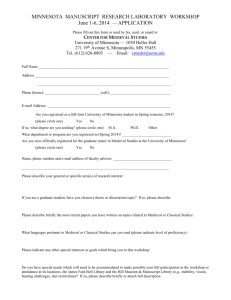Animal Life Cycles
advertisement
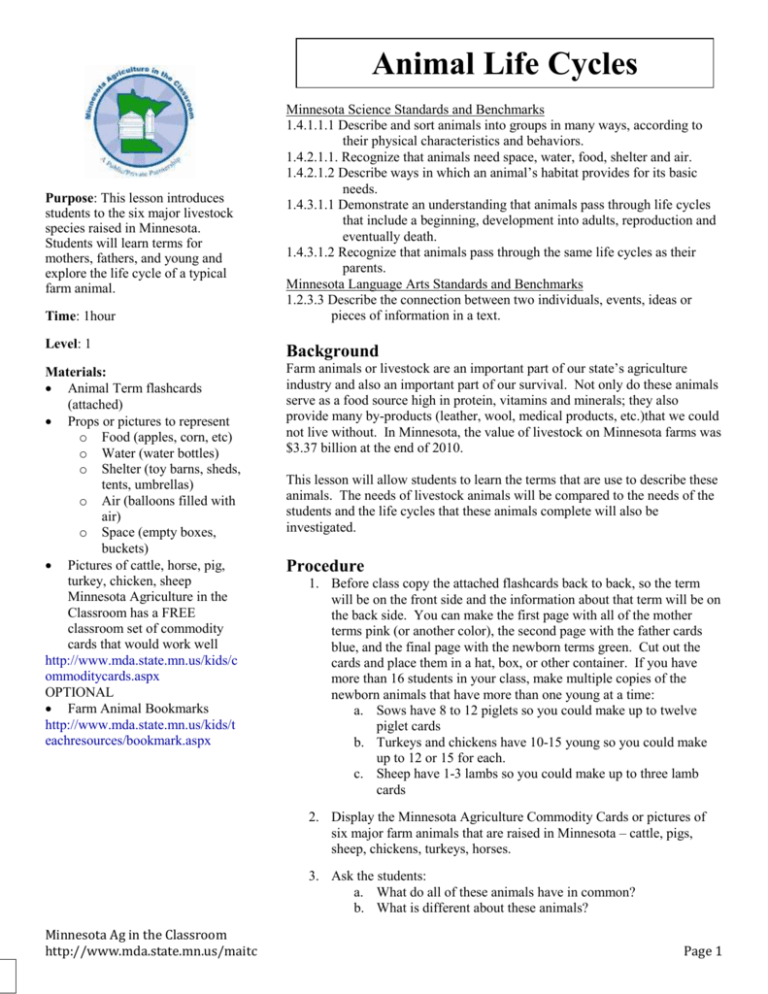
Animal Life Cycles Purpose: This lesson introduces students to the six major livestock species raised in Minnesota. Students will learn terms for mothers, fathers, and young and explore the life cycle of a typical farm animal. Time: 1hour Minnesota Science Standards and Benchmarks 1.4.1.1.1 Describe and sort animals into groups in many ways, according to their physical characteristics and behaviors. 1.4.2.1.1. Recognize that animals need space, water, food, shelter and air. 1.4.2.1.2 Describe ways in which an animal’s habitat provides for its basic needs. 1.4.3.1.1 Demonstrate an understanding that animals pass through life cycles that include a beginning, development into adults, reproduction and eventually death. 1.4.3.1.2 Recognize that animals pass through the same life cycles as their parents. Minnesota Language Arts Standards and Benchmarks 1.2.3.3 Describe the connection between two individuals, events, ideas or pieces of information in a text. Level: 1 Background Materials: Animal Term flashcards (attached) Props or pictures to represent o Food (apples, corn, etc) o Water (water bottles) o Shelter (toy barns, sheds, tents, umbrellas) o Air (balloons filled with air) o Space (empty boxes, buckets) Pictures of cattle, horse, pig, turkey, chicken, sheep Minnesota Agriculture in the Classroom has a FREE classroom set of commodity cards that would work well http://www.mda.state.mn.us/kids/c ommoditycards.aspx OPTIONAL Farm Animal Bookmarks http://www.mda.state.mn.us/kids/t eachresources/bookmark.aspx Farm animals or livestock are an important part of our state’s agriculture industry and also an important part of our survival. Not only do these animals serve as a food source high in protein, vitamins and minerals; they also provide many by-products (leather, wool, medical products, etc.)that we could not live without. In Minnesota, the value of livestock on Minnesota farms was $3.37 billion at the end of 2010. This lesson will allow students to learn the terms that are use to describe these animals. The needs of livestock animals will be compared to the needs of the students and the life cycles that these animals complete will also be investigated. Procedure 1. Before class copy the attached flashcards back to back, so the term will be on the front side and the information about that term will be on the back side. You can make the first page with all of the mother terms pink (or another color), the second page with the father cards blue, and the final page with the newborn terms green. Cut out the cards and place them in a hat, box, or other container. If you have more than 16 students in your class, make multiple copies of the newborn animals that have more than one young at a time: a. Sows have 8 to 12 piglets so you could make up to twelve piglet cards b. Turkeys and chickens have 10-15 young so you could make up to 12 or 15 for each. c. Sheep have 1-3 lambs so you could make up to three lamb cards 2. Display the Minnesota Agriculture Commodity Cards or pictures of six major farm animals that are raised in Minnesota – cattle, pigs, sheep, chickens, turkeys, horses. 3. Ask the students: a. What do all of these animals have in common? b. What is different about these animals? Minnesota Ag in the Classroom http://www.mda.state.mn.us/maitc Page 1 c. If we were going to sort them into different groups, how would you sort them? Why? (Examples: two legs vs. four legs; feathers vs. hair/fur; big vs. small) 4. Ask the students what these animals need to survive. When a student supplies one of the five elements of survival (food, water, shelter, space, air), ask which of the animals need that element (all animals do!) Have a volunteer come and hold the prop by each animal picture so by the end of the discussion each animal will have five prop holders next to it. Help students understand that this visual representation shows us that all of these animals need food, water, shelter, space and air to survive. 5. Ask students how the animals get these items needed for survival? (Farmers provide them with food, water, shelter and space. The atmosphere provides air that animals breathe - just like humans.) 6. Inform the students that farmers need to know a lot about their animals to make sure that the animals are taken care of and grow big and strong because they provide food for us. Today, the students get to learn about these animals just like these important farmers do. 7. Explain to the students that in your container (box, hat, etc) you have cards that represent a mother, father and baby for each of the livestock animals. Show students the designated place in the room where each livestock species will gather – Example: The mother sheep, father sheep, and baby sheep will all gather in the front corner. You can place the picture of the livestock animal (used earlier in this lesson) in the location to clarify where each animal species should gather. 8. Have each student draw an animal card from your container and then travel to their designated gathering spot. 9. Instruct the students to share the information on their card with the other students in their gathering spot. 10. Ask for animal groups to volunteer and share the information about the mother, father, and young to the rest of the class. 11. Discuss with students how these animal families or groups change over time. Help students understand: a. Young/babies will grow and become mothers and fathers b. Mothers and fathers will continue to have babies c. Mothers and fathers will grow old and eventually die i. All animal species can be used for meat and many other by-products. See additional lessons: 12. Hand out the Farm Animal bookmarks from Minnesota Agriculture in the Classroom. http://www.mda.state.mn.us/en/kids/teachresources/bookmark.aspx Review with the students the animals that were discussed in class and also point out the additional animals included on the book marks. Additional Activities Minnesota Ag in the Classroom http://www.mda.state.mn.us/maitc Page 2 Minnesota Ag in the Classroom http://www.mda.state.mn.us/maitc Go to the Minnesota Agriculture in the Classroom website to view videos on livestock production in Minnesota. http://www.mda.state.mn.us/kids/videostories/livestock.aspx Visit a local farm to see real-life farm animals. Visit the Minnesota Zoo’s Family Farm or use their website to get additional insight into Minnesota’s farm animals. http://www.mnzoo.com/animals/animals_familyFarm.asp Create an opportunity for students to write about a day in the life of a specific animal. A writing prompt might be: I woke up this morning and I had magically been transformed into a ______________ (calf, bull, hen, etc.) Page 3 Mare Sow Hen Hen Ewe Cow Minnesota Ag in the Classroom http://www.mda.state.mn.us/maitc Page 4 A mother horse is called a mare. A mare is pregnant for about 11 months than she gives birth to a foal. A mother pig is called a sow. When she gives birth to piglets, the process is called farrowing. A mother chicken is called a hen. Hens lay eggs. Twenty-one days after the eggs are laid they hatch into chicks. A mother turkey is called a hen. Hens lay eggs. Twentyeight days after the eggs are laid they hatch into young turkeys called poults. Cattle are used for beef A mother sheep is called a (meat) or dairy (milk). ewe. Ewes usually give Mother beef or dairy birth in early spring to one animals are called cows. or two lambs at once. When Cows are pregnant for nine a ewe gives birth it is called months than they give birth lambing. to a calf. Minnesota Ag in the Classroom http://www.mda.state.mn.us/maitc Page 5 Stallion Boar Tom Rooster Bull Minnesota Ag in the Classroom http://www.mda.state.mn.us/maitc Ram Page 6 A father horse is called a stallion. A father turkey is called a tom. Toms eat corn, soybeans, vitamins and minerals. Farmers provide fresh water at all times. Cattle are used for beef (meat) or dairy (milk). Father beef or dairy animals are called bulls. Bulls eat corn and alfalfa and can drink 35 gallons of water a day. Minnesota Ag in the Classroom http://www.mda.state.mn.us/maitc A father pig is called a boar. Boars eat ground corn, soybean meal, vitamins and minerals. They also drink two gallons of water every day. A father chicken is called a rooster. Roosters live in large buildings where they have water and eat corn and soybeans. A father sheep is called a ram. A ram eats grain like corn and oats, and also grass and alfalfa. A farmer will give a ram fresh water every day. Page 7 Foal Piglet Poult Chick Calf Lamb Minnesota Ag in the Classroom http://www.mda.state.mn.us/maitc Page 8 A newborn pig is called a A newborn horse is called a piglet. Piglets weigh about 3 foal. A foal that is a girl is pounds when they are born. called a filly. A goal that is a Piglets are about 11 inches boy is called colt. or 29 centimeters long when they are born. A newborn turkey is called a poult. Turkey farmers provide shelter for poults to protect them from predators and the weather. A new born chicken is called a chick. Each chick uses it beak to break out of its eggshell. A newborn sheep is called a A newborn beef or dairy lamb. Lambs eight between animal is called a calf. A calf eight and ten pounds when weighs between 75 and 100 they are born. Once lambs pounds when it is born. turn one year old, they are called sheep. Minnesota Ag in the Classroom http://www.mda.state.mn.us/maitc Page 9


